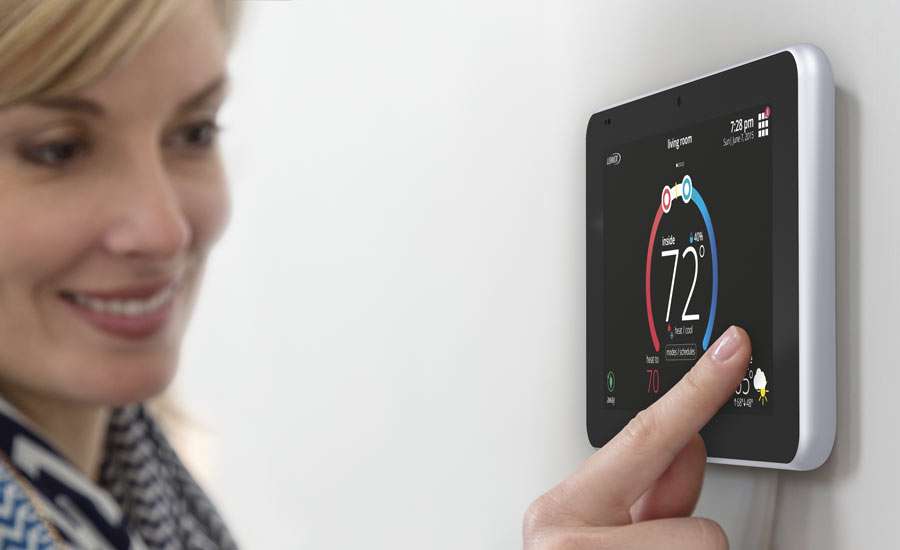Optimizing your thermostat settings can bring you the perfect balance between energy savings and comfort. In this blog post, we’ll be talking all about how to master home comfort by optimizing thermostat settings like a pro. We’ll discuss the different types of thermostats available, from traditional to smart, as well as the importance of consulting a professional HVAC technician for installation and maintenance.
Understanding the Basics of Thermostats
Thermostats are an essential component of every heating and cooling system, allowing you to control the temperature of your home with ease. Understanding the basics of thermostats is crucial to optimizing your comfort and energy savings.
At their core, thermostats are devices that measure the temperature in your home and send signals to your heating and cooling system to maintain the desired temperature. They come in various types, including manual or traditional thermostats and smart thermostats.
Traditional thermostats are the classic choice and offer a straightforward way to control the temperature. They typically have manual controls, such as dials or buttons, making it easy to adjust the temperature. Traditional thermostats are budget-friendly and reliable, but they lack advanced features like programmable schedules or remote control.
On the other hand, smart thermostats are the new generation of thermostats that take comfort and energy efficiency to a whole new level. These technologically advanced devices can learn your preferences, adjust the temperature automatically, and even connect to weather forecasts to optimize your comfort and energy savings. With features like remote control through smartphone apps and detailed energy reports, smart thermostats offer convenience and efficiency like never before.
Whether you choose a traditional or smart thermostat, understanding the basics of how they work and the features they offer is essential for optimizing your home comfort.
The Pros and Cons of Traditional Thermostats
Traditional thermostats have been a popular choice for many homeowners due to their simplicity and reliability. With manual controls, such as dials or buttons, they offer a straightforward way to adjust the temperature in your home. These thermostats are budget-friendly and can effectively maintain a comfortable environment. However, they do have some limitations.
One of the main drawbacks of traditional thermostats is their lack of advanced features. Unlike smart thermostats, they cannot learn your preferences or automatically adjust the temperature based on your schedule or occupancy. This means that you may need to constantly adjust the thermostat to maintain the desired comfort level.
Additionally, traditional thermostats do not offer remote control or connectivity features. You cannot control them through smartphone apps or receive detailed energy reports. This limits the convenience and energy-saving capabilities that smart thermostats provide.
Another consideration is the potential for human error with manual thermostats. Forgetting to adjust the temperature when leaving the house or going to bed can result in wasted energy and increased utility bills.
How Smart Thermostats Work
Smart thermostats are a revolutionary technology that brings convenience and efficiency to managing your home temperature. These intelligent devices utilize advanced features and connectivity to ensure optimal comfort and energy savings. But how exactly do smart thermostats work?
Smart thermostats work by connecting to your home’s Wi-Fi network, allowing you to control them remotely through smartphone apps or voice assistants like Amazon Alexa or Google Assistant. They also have sensors that measure factors like temperature, humidity, and occupancy, which helps them make automatic adjustments to maintain the desired comfort level.
One of the key features of smart thermostats is their ability to learn your preferences and adapt accordingly. They analyze your behavior patterns, such as when you come and go, and create a schedule based on your routine. This means that you don’t have to constantly adjust the thermostat as it will automatically raise or lower the temperature to ensure your home is comfortable when you’re there and conserve energy when you’re not.
Smart thermostats also have features like geofencing, which uses your smartphone’s GPS to detect when you’re away from home. This triggers the thermostat to adjust the temperature to an energy-saving level until you return.
In addition, many smart thermostats can connect to weather forecasts, allowing them to anticipate changes in temperature and adjust accordingly. This ensures that your home remains comfortable no matter what the weather is like outside.
Overall, smart thermostats offer an intelligent and intuitive way to manage your home temperature. They learn your preferences, adapt to your schedule, and optimize energy usage, all while providing maximum comfort.
Benefits of Smart Thermostats
Smart thermostats offer a multitude of benefits that can significantly enhance your home comfort and energy savings. By upgrading to a smart thermostat, you can enjoy a range of advantages that traditional thermostats simply cannot provide.
Smart thermostats offer unparalleled convenience. With the ability to control your thermostat remotely through smartphone apps or voice assistants, you have the power to adjust your home’s temperature from anywhere. Forgot to adjust the thermostat before leaving for vacation? No problem! Simply use your smartphone to ensure your home remains at an energy-saving temperature while you’re away.
In addition to convenience, smart thermostats are designed to optimize energy savings. With features like learning your preferences, creating personalized schedules, and automatically adjusting the temperature based on occupancy and weather forecasts, smart thermostats help reduce energy consumption and lower utility bills. They can even provide detailed energy reports, allowing you to track and monitor your usage over time.
Furthermore, smart thermostats offer a higher level of comfort. Their ability to adapt to your routine and maintain a consistent temperature throughout the day ensures that you always come home to a comfortable environment. No more walking into a chilly house or feeling too hot in the summer.
Optimizing Your Thermostat Settings for Energy Savings
Now that you have a basic understanding of how thermostats work and the benefits of upgrading to a smart thermostat, let’s dive into some tips for optimizing your thermostat settings for energy savings. By following these tips, you can maximize your comfort while also reducing your energy consumption.
First, take advantage of the programming features on your thermostat. Set different temperatures for different times of the day to ensure your home is comfortable when you’re there and save energy when you’re away. For example, you can program your thermostat to lower the temperature when you’re at work and raise it just before you come home, so you’re welcomed by a cozy environment.
Next, consider the layout of your home and the placement of your thermostat. Avoid placing it near direct sunlight, drafts, or heat-emitting appliances, as this can affect the temperature readings and lead to unnecessary adjustments. Additionally, make sure your thermostat is installed in a central location where it can sense the average temperature of your home.
Regularly checking and replacing your air filters is another important step in optimizing your thermostat settings. Dirty filters can restrict airflow, making your heating and cooling system work harder and potentially decreasing efficiency. By keeping your filters clean, you can ensure that the air in your home is circulating properly and that your system is operating at its best.
Finally, pay attention to the humidity levels in your home. Investing in a humidifier or dehumidifier can greatly enhance your comfort by balancing the moisture levels in the air. Proper humidity control can prevent dryness or excessive moisture, which can impact your overall comfort and even your health.
Professional Thermostat Installation and Maintenance
Professional installation and maintenance of your thermostat is crucial to ensuring its optimal performance and longevity. While installing a thermostat may seem like a simple task, it’s important to remember that it is a part of a larger HVAC system that requires professional expertise. HVAC technicians have the knowledge and experience to properly install your thermostat, ensuring that it is compatible with your heating and cooling system and wired correctly.
In addition, professional technicians can provide valuable insights and recommendations on the best thermostat for your specific needs. They can assess your home’s layout, insulation, and HVAC system to determine the most suitable thermostat for optimal energy efficiency and comfort.
Regular maintenance by an HVAC professional is also essential for keeping your thermostat in top shape. Technicians can perform routine checks, clean and calibrate the thermostat, and make any necessary adjustments or repairs. This helps prevent malfunctions, improves efficiency, and extends the lifespan of your thermostat.
By investing in professional installation and maintenance, you can have peace of mind knowing that your thermostat is working effectively and efficiently. This not only ensures your comfort but also helps you save on energy costs in the long run. Don’t hesitate to consult a the HVAC professionals at Home Comfort USA to get the most out of your thermostat and enjoy a comfortable and efficient home environment.






